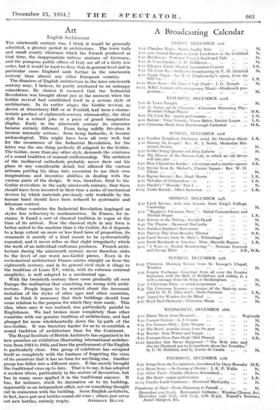Art
English Architecture Tax nineteenth century was, I think it would be generally admitted, a gloomy period in architecture. The town halls and small county chateaux which the French produced at that time, the inappropriate railway stations of Germany, and the pompous public offices of Italy are all of a fairly low order, but it would be hard to deny that in general level and in particular cases -England sank further in the nineteenth century than almost any other European country. The disasters of English architecture in the later nineteenth century may, I believe, be partly attributed to an unhappy coincidence. By chance it occurred that the Industrial Revolution was brought about just at the moment when the Gothic revival had established itself in a serious style of architecture. In its earlier stages the Gothic revival, as shown at Strawberry Hill or at Fonthill, had been a charac- teristic product of eighteenth-century whimsicality, the ideal style for a refined joke or a piece of grand imaginative display. Early in the nineteenth century its character became entirely different. From being mildly frivolous it became intensely serious ; from being fantastic, it became archaeological. This might have been all very well, but for the occurrence of the Industrial Revolution, for the latter was the one thing perfectly ill adapted to the Gothic. The Gothic, more than any other style, demands the existence of a sound tradition of manual craftsmanship. The architect of the mediaeval cathedrals probably never drew out his plans in any considerable detail, but allowed the various artisans putting his ideas into execution to use their own imaginations and inventive abilities in dealing with the various parts of the design. It was, therefore, fatal to the Gothic revivalists in the early nineteenth century, that there should have been invented in their time a series of mechanical devices by which materials previously only workable by the human hand should have been reduced to systematic and inhuman control.
In other countries the Industrial Revolution impinged on styles less refractory to mechanization. In France, for in- stance, it found a sort of classical tradition in vogue at the time of its arrival. Now the classical style in any form is better suited to the machine than is the Gothic, for it depends to a large extent on more or less fixed laws of proportion, its ornament is mainly of a kind meant to be systematically repeated, and it never relies on that slight irregularity which the work of an individual craftsman produces. French archi- tecture during the nineteenth century never therefore sinks to the level of our worst neo-Gothic pieces. Even in its ecclesiastical architecture France carries straight on from the eighteenth century, and in its general civil style it clings to the tradition of Louis XV, which, with its extreme external simplicity, is well adapted to a mechanical age.
With the twentieth century there came gradually all over Europe the realization that something was wrong with archi- tecture. People began to be worried about the incessant imitation of the styles of other ages and other countries, and to think it necessary that their buildings should bear some relation to the purpose for which they were made. This idea, when once it was realized, was particularly painful to Englishmen. We had broken more completely than other countries with our genuine tradition of architecture, and had plunged far more wholeheartedly down the by-path of the neo-Gothic. It was therefore harder for us to re-establish a sound tradition of architecture than for the Continent.
The Royal Institute of British Architects has organized in its
neve premises an exhibition illustrating international architec- ture from 1924 to 1934, and here the predicament of the English is particularly clear. One group of exhibitors has occupied itself so completely with the business of forgetting the vices of its ancestors that it has no time for anything else. Another group has fallen into a different snare. It has merely brought the traditional vices up to date. That is to say, it has adopted a modern idiom, particularly in the matter of decoration, but has in many cases applied it in the traditional Manner. It has, for instance, stuck its decoration on to its building, apparently as an independent affair, not on something thought out in connexion with the building. Some English architects, in fact, have put new bottles round old wine ; others just serve out new bottles, entirely empty. Awn:form MAIN*.


































 Previous page
Previous page